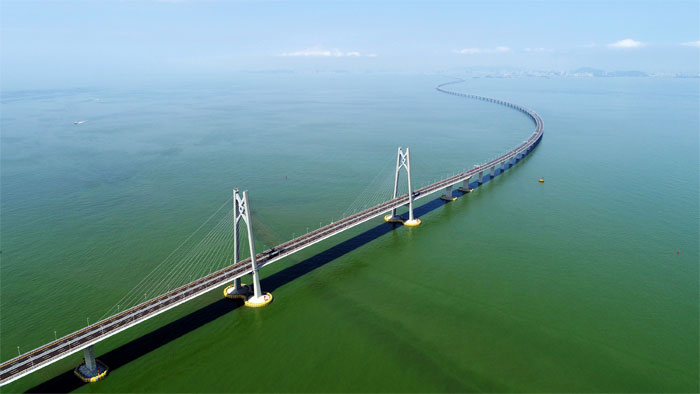
Co-Authors : Khalid Lateef is a Regional President of Iqbal Research Institute Lahore, (Indian Administered Jammu and Kashmir Branch) located at Trehgam, District Kupwara. He is an Independent researcher of Iqbaliyaat, Hebrew Bible, and Comparative Study of Religions and Iqbal Study in reference with Reunification of Science, History, Archaeology, and Humanities. He can be reached at: khalidlateef012@gmail.com.
China and Pakistan has been two brotherly nieghbours since 74 years. The evolution of China into an better economic society has wholly or partially an effect on global world. So eventually the world is running towards development.
Pakistan and China has started this Corridor several years ago to ensure the development of the South-Asian states. Firstly, we shall look at the facts that what was the real ambition of CPEC. In its full form, it means China-Pakistan Economic Corridor.
While investigating the historical perspectives of the Pakistan-China Relation’s, we find its inception since 1950’s.Pakistan’s close relationship with China dates back to 1951 when diplomatic relations were formally established between the two countries. Economic growth in the country however, has historically been stifled due to decades of conflict, macro-management issues, and an energy starved economy. ”To capitalize on its shortcomings and tackle its crippled energy sector, significant foreign direct investment is required to open up numerous opportunities for the state and investors. In light of the closeness of Sino-Pak ties, China is considered to be the most reliable partner, especially since relationships with other regional and global powers have proven difficult.”
CPEC is a well planned corridor. It constitutes an array of different energy projects, transportation/infrastructure networks, and economic free zones within Islamic Republic of Pakistan. This investment is a part of China’s the Belt and Road Initiative (BRI), which includes the Silk Road Economic Belt and the 21st Century Maritime Silk Road. The investment included a total sum of $46 billion directed at upgrading Pakistan’s existing transportation infrastructure, as well as boosting Pakistan’s energy generation capacity. “The proposed special economic zones (SEZs) would follow if the energy and infrastructure projects prove successful. CPEC links the strategically significant city of Kashgar in China’s Xinjiang to the port of Gwadar in Pakistan’s Balochistan province. The proposed route allows the passage of goods and services between China and Pakistan.”

The Components of China Pakistan Economic Corridor (CPEC) are:
1. Pakistan’s Energy Sector
2. Transportation Infrastructure
3. Special Economic Zones
Strategic Rationales of Chinese Think Tanks on China Pakistan Economic Corridor (CPEC)
1. International Relations Theories
For China, CPEC is an integral component of its 21st-century in Central Asia and world globally. BRI initiative promoting economic expansion and regional connectivity while reinforcing its status as a global player in international affairs. CPEC’s motivations can be explained through the prism of realist and liberal internationalist theories of geopolitics, as there are elements of both competition and cooperation driving state behavior.”
2. The Liberalist Motives of the People’s Republic of China
The liberalist argument holds that CPEC is based upon China’s relationship with Pakistan and its
foreign policy principles of non-interference and non-aggression in line with Five Principles of Peaceful Coexistence. One of the five principles is “equality and cooperation for mutual benefit.” In line with this principle, mutual benefits and the degree of utility for Pakistan’s economy are likely key considerations while carrying out investments. In addition to establishing its status as a great power globally, investing in countries such as Pakistan could also reinforce China’s image as a country that cooperates with states by investing in human capital, businesses, and infrastructure without violating a state’s sovereignty.”
The Pakistani Views on China Pakistan Economic Corridor are:
1. The closeness of Sino-Pak Ties.
2. Economic Growth in the country.
3. Energy Generation and Cooperation.
4. Transportation Infrastructure.
5. Upgrading Pakistan’s existing transportation infrastructure through investments is a salient feature of CPEC.
6. Transportation of goods and services to different provinces and financial centers both opens up Pakistan to the Chinese market and allows China to export its products to Pakistan’s domestic consumers.
7. Regional Connectivity and ‘Crowding In’ Benefits.
8. Security: Pakistan continues to grapple with internal security challenges, with terrorist groups such as Tehrik-i-Taliban Pakistan (TTP) targeting civilian and military institutions.To ensure security along CPEC, the Pakistan Army has developed the Special Security Division (SSD). The SSD comprises nine army infantry battalions and six civil armed forces wings for a total of 12,000 troops.
Citaions
1. China Radio International, Full Text: Vision and Actions on Jointly Building Belt and Road, report, March 29, 2015, http://english.cri.cn/12394/2015/03/29/2941s872030_1.htm.
2. “GDP Ranking Data,” The World Bank, 2015, http://data.worldbank.org/data-catalog/GDP-ranking-table.
3. Daniel S. Markey and James West, “Behind China’s Gambit in Pakistan,” The Council for Foreign Relations, May 12, 2016, http://www.cfr.org/pakistan/behind-chinas-gambit-pakistan/p37855.
4. Andrew Small, The China-Pakistan Axis: Asia’s New Geopolitics. New York, NY: Oxford University Press, 2015.
5. Saeed Shah, “China’s Xi Jinping Launches Investment Deal in Pakistan,”The Wall Street Journal, April 20, 2015,
6. http://www.wsj.com/articles/chinas-xi-jinping-set-to-launch-investment-deal-in-pakistan-1429533767.
7. “One Belt, One Road,”Caixin, December 10, 2014, http://english.caixin.com/2014-12-10/100761304.html.
8. Andrew Small, “CPEC: Road to the Future?” Herald, November 15, 2016, http://herald.dawn.com/news/1153559.
9. Ahmad Rashid Malik, “A Miracle on the Indus River?”The Diplomat, December 7, 2015 http://thediplomat.com/2015/12/a-miracle-on-the-indus-river/.
10. Saeed Shah, “China to Build Pipeline from Iran to Pakistan,”The Wall Street Journal, April 9, 2015, http://www.wsj.com/articles/china-to-build-pipeline-from-iran-to-pakistan-1428515277.
11. Declan Walsh, “After Decades of Neglect, Pakistan Rusts in Its Tracks,”The New York Times, May 18, 2013, http://www.nytimes.com/2013/05/19/world/asia/pakistans-railroads-sum-up-nations-woes.html?_r=0.
12. Michael Kugelman, “Pakistan’s Other National Struggle: Its Energy Crisis,”The Wall Street Journal, July 9, 2015, http://blogs.wsj.com/washwire/2015/07/09/pakistans-other-national-struggle-its-energy-crisis/.
13. “Karachi to Lahore Motorway Project Approved,”Dawn, July 4, 2014, http://www.dawn.com/news/1116948.
14. Claude Rakisits, “A Path to the Sea: China’s Pakistan Plan,”World Affairs 178, no. 3 (Fall 2015): 67-74.
15. Iftikhar Alam, “CPEC May Get Extra Billion Dollars,”The Nation, June 22, 2015, http://nation.com.pk/national/22-Jun-2015/cpec-may-get-extra-billion-dollars.
16. Naveed Butt, “Economic Corridor: China to Extend Assistance at 1.6 Percent Interest Rate,”Business Recorder, September 3, 2015, http://www.brecorder.com/market-data/stocks-a-bonds/0/1223449/.
17. Balochistan: Giving the People a Chance, report (Lahore: Human Rights Commission of Pakistan, 2013), 5, http://www.hrcp-web.org/hrcpweb/wp-content/pdf/Balochistan%20Report%20New%20Final.pdf.
18. Abid, Massarrat, and Ayesha Ashfaq. 2015. Cpec: Challenges and opportunities for pakistan. Journal of Pakistan Vision 16: 142-69.
19. Ahmed, Hafiz Zafar, Noor Ul Ain Khan, Sara Sajjad, and Dawood Ahmed. 2018. Evaluation of Strategic Importance of CPEC: A Comparative Study with Panama Canal Project and Suez Canal Project. A Research Journal of Commerce, Economics, and Social Sciences 12: 112-19. doi:10.24312/paradigms120116.
20. Ahmed, Riaz, and Usman Mustafa. 2014. Impact of CPEC Projects on Agriculture Sector of Pakistan: Infrastructure and Agricultural Output Linkages. Available online: https://www.pide.org.pk/psde/pdf/AGM32/papers/Impact%20of%20CPEC%20Projects%20on%20Agriculture%20Sector%20on%20Pakistan.pdf (accessed on August 20, 2019).
21. Ali, Akber. 2016. China Pakistan Economic Corridor: Prospects and Challenges for Regional Integration. Arts and Social Sciences Journal 7: 3-7. doi:10.4172/2151-6200.1000204.
22. Ali, Yousaf, Zaeem Rasheed, Noor Muhammad, and Salman Yousaf. 2017. Energy optimization in the wake of China Pakistan Economic Corridor ( CPEC ) Energy optimization in the wake of China Pakistan Economic Corridor ( CPEC ). Journal of Control and Decision 1-19. doi:10.1080/23307706.2017.1353929.
23. Anwar, Zahid. 2010. Gwadar Deep Sea Port’s Emergence as Regional Trade and Transportation Hub: Prospects and Problems. Journal of Political Studies 17: 97-112.
24. Ashraf, Sajjad. 2015. China Pakistan Economic Corridor. Institute of South Asian Studies 364: 1-4. doi:10.2139/ssrn.2608927.
25. Biesenthal, Christopher, and Ralf Wilden. 2014. ScienceDirect Multi-level project governance: Trends and opportunities. JPMA 32: 1291-308. doi:10.1016/j.ijproman.2014.06.005. Board of Investment. 2016. China Pakistan Economic Corridor (CPEC). Islamabad: Board of Investment.
26. Chaziza, Mordechai. 2016. China-Pakistan Relationship: A Game-changer for the Middle East? Contemporary Review of the Middle East 3: 147-61. doi:10.1177/2347798916638209.
27. China-Britain Business Council. 2016. One Belt One Road: A Role for UK Companies in Developing China’s New Initiative. London: China-Britain Business Council, p. 28.
28. Coyne, Imelda T., Hons Dipn, and Rscn Rgn. 1997. Sampling in qualitative research. Purposeful and theoretical sampling; merging or clear boundaries? JAN 26: 623-30.
29. Estache, Antonio, and Grégoire Garsous. 2012. The impact of infrastructure on growth in developing countries. IFC Economics Notes 1. doi:10.4018/978-1-5225-2361-1.ch003.
30. Fakhar Hussain, Mezhar Hussain. 2017. China-Pak Economic Corridor (CPEC) And Its Geopolitical Paradigms. IJSSHE-International Journal of Social Sciences, Humanities and Education 1: 1-17.
31. Fedderke, Johannes W., P. Perkins, and John Luiz. 2006. Infrastructural investment in long-run economic growth: South Africa 1875-2001. World Development 34: 1037-59. doi:10.1016/j.worlddev.2005.11.004.
32. Ferdinand, Peter. 2016. Westward ho???the China dream and one belt, one road???: Chinese foreign policy under Xi Jinping. International Affairs 92: 941-57. doi:10.1111/1468-2346.12660.
33. Garrett-Peltier, Heidi. 2010. Estimating the employment impacts of pedestrian, bicycle, and road infrastructure-case study: Baltimore. Available online: https://trid.trb.org/view/1094074 (accessed on August 20, 2019)
34. Haq, Rashida and Nadia Farooq. 2017. Impact of cpec on social welfare in pakistan: A district level analysis. In 32nd Annual General Meeting and Conference (2016).
35. Harvey, Hurricane,Wenlin Liu, Chih-hui Lai, andWeiaiWayne. 2018. Tweeting about emergency: A semantic network analysis of government organizations’ social media messaging during. Public Relations Review 44: 807-19. doi:10.1016/j.pubrev.2018.10.009.
36. Ibrar, Muhammad, Jianining Mi, Muhammad Rafiq, and Liaqat Ali. 2019. China-Pakistan Economic Corridor: Ensuring Pakistan’ s Economic Benefits. Khazar Journal of Humanities & Social Sciences 22: 38-51. doi:10.5782/2223-2621.2019.22.1.38.
37. International Labor Organization. 2011. Local Development through Infrastructure Investments and Jobs-Advisory Support, Information Services and Training Programme (ASIST-AP). Geneva: International Labor Organization.
38. Economies 2019, 7, 90 14 of 14
39. Irshad, Muhammad Saqib, Qi Xin, and Hamza Arshad. 2015. One Belt and One Road: Dose China-Pakistan Economic Corridor benefit for Pakistan’ s Economy? Journal of Economics and Sustainable Development 6: 200-7.
40. Javaid, Umbreen. 2016. Assessing CPEC: Potential Threats and Prospects. Pakistan Economic and Social Review 54:123-42.
41. Jetin, Bruno. 2017. “One Belt- One Road Initiative” and ASEAN Connectivity: Synergy Issues and Potentialities. In China’s Global Rebalancing and the New Silk Road. Singapore: Springer, pp. 139-50.
42. Malik, Hasan Yaser. 2012. Strategic Importance of Gwadar Port. Journal of Political Studies 19: 57-69.
43. Marshall, Andrew Gavin. 2016. “Integrate, But Hedge”: China In the Age of Global Governance, Part I. OCCUPY, January 26.
44. Ministry of Planning Development and Reforms. 2013. China Pakistan Economic Corridor. Islamabad: Ministry of Planning Development and Reforms. Ministry of Planning Development and Reforms. 2019. Is CPEC Becoming Another East India Company? Islamabad: Ministry of Planning Development and Reforms.
45. Mumtaz, Muhammad Zubair, Zachary Alexander Smith, and Ashfaque H Khan. 2016. An Analysis of Chinese Outward Foreign Direct Investment in Emerging and Developing Countries: Implications for Pakistan under CPEC. The Journal of Social, Political, and Economic Studies 42(3/4), 327-367.
46. Pravakar Sahoo, Ranjan Kumar Dash. 2010. Infrastructure Development and Economic Growth in China Economic Growth in China. January. Available online: https://pdfs.semanticscholar.org/d701/da02e0f795c310e56b7f36877dc3017033c8.pdf (accessed on 2 September, 2019)
47. Quora. 2017. What Would Be the Impact of China-Pakistan Economic Corridor (CPEC) on Pakistan’s Economy in the Short-Term and the Long-Run? Mountain View: Quora.
48. Ramachandran, Sudha. 2015, Jul. China-pakistan economic corridor: Road to riches?
49. Sheu, Jiuh Biing, and Tanmoy Kundu. 2017. Forecasting time-varying logistics distribution flows in the One elt-One Road strategic context. Transportation Research Part E 117: 5-22. doi:10.1016/j.tre.2017.03.003.
50. The Wall Street. 2015. CPEC Map. Available online: https://www.wsj.com/articles/china-to-unveil-billions-ofdollars- in-pakistan-investment-1429214705 (accessed on April 15, 2019)
51. The Week. 2017. China’s plan to run the world. The Week, June 10.
52. Tongco, Ma Dolores C. 2007. Purposive Sampling as a Tool for Informant Selection. Ethnobotany Research and Applications 5: 147-58.
53. U.S. Energy Information Administration. 2012. The Strait of Hormuz Is the World’s Most Important Oil Transit Chokepoint.lWashington, DC: U.S. Energy Information Administration.
54. Xinhua News. 2015. Vision and Actions on Jointly Building Belt and Road. Xinhua News, March 28.
55. Yang, Dong, Liping Jiang, and Adolf K. Y. Ng. 2018. One Belt one Road , but several routes: A case study of new emerging trade corridors connecting the Far East to Europe. Transportation Research Part A 117: 190-204. doi:10.1016/j.tra.2018.08.001.
56. Zia, Muhammad Muzammil. 2017. The Impact of CPEC & Related Road Infrastructure Projects on Employment. 011. Islamabad: Centre of Excellence for CPEC.
57. Zia, Muhammad Muzammil, Shujaa Waqar, and Beenash Afzal Malik. 2018. Special Economic Zones (SEZs): A Comparative Analysis for CPEC SEZs in Pakistan. Islamabad: Centre of Excellence for CPEC, pp. 37-60.






